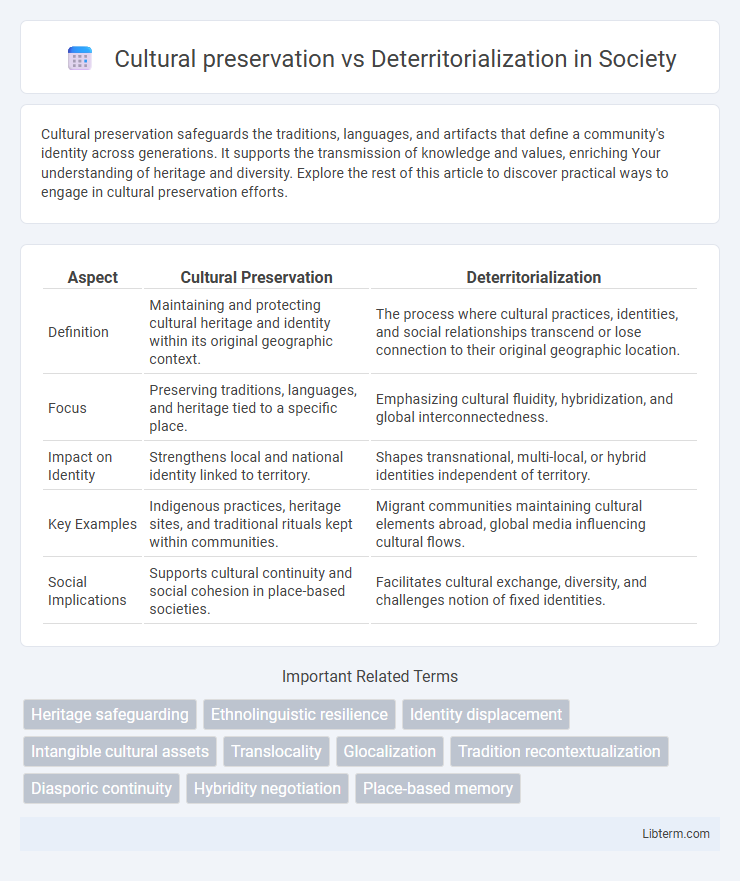Cultural preservation safeguards the traditions, languages, and artifacts that define a community's identity across generations. It supports the transmission of knowledge and values, enriching Your understanding of heritage and diversity. Explore the rest of this article to discover practical ways to engage in cultural preservation efforts.
Table of Comparison
| Aspect | Cultural Preservation | Deterritorialization |
|---|---|---|
| Definition | Maintaining and protecting cultural heritage and identity within its original geographic context. | The process where cultural practices, identities, and social relationships transcend or lose connection to their original geographic location. |
| Focus | Preserving traditions, languages, and heritage tied to a specific place. | Emphasizing cultural fluidity, hybridization, and global interconnectedness. |
| Impact on Identity | Strengthens local and national identity linked to territory. | Shapes transnational, multi-local, or hybrid identities independent of territory. |
| Key Examples | Indigenous practices, heritage sites, and traditional rituals kept within communities. | Migrant communities maintaining cultural elements abroad, global media influencing cultural flows. |
| Social Implications | Supports cultural continuity and social cohesion in place-based societies. | Facilitates cultural exchange, diversity, and challenges notion of fixed identities. |
Understanding Cultural Preservation in the Modern World
Cultural preservation involves safeguarding traditions, languages, and heritage to maintain community identity amid globalization and rapid change. It prioritizes the protection of tangible and intangible cultural assets, reinforcing social cohesion and historical continuity. Understanding cultural preservation in the modern world requires recognizing its role in resisting deterritorialization, where cultural elements lose connection to their geographic origins and become homogenized or commodified.
The Concept of Deterritorialization Explained
Deterritorialization refers to the process by which cultural practices, identities, and meanings are uprooted from their original geographic and social contexts, leading to the transformation of cultural expressions outside of their traditional territories. This concept highlights how globalization, migration, and digital communication contribute to the displacement and reconfiguration of cultural elements, challenging conventional notions of cultural preservation tied to fixed locations. The tension between cultural preservation and deterritorialization lies in balancing the safeguarding of heritage with the dynamic evolution of culture through translocal interactions and hybrid identities.
Historical Roots of Cultural Preservation
Historical roots of cultural preservation trace back to efforts by indigenous communities and ancient civilizations to maintain language, customs, and artifacts amid foreign invasions and colonization. Practices such as oral storytelling, ritual ceremonies, and archival documentation served as tools to reinforce identity and resist cultural erasure. These origins highlight cultural preservation as a form of resilience against deterritorialization, where displacement and globalization threaten the continuity of localized cultural heritage.
Globalization as a Driver of Deterritorialization
Globalization acts as a powerful driver of deterritorialization by disrupting traditional cultural boundaries and facilitating the flow of ideas, values, and practices across geographic borders. This process often challenges cultural preservation efforts as local identities become hybridized or diluted through global media, migration, and transnational networks. Cultural preservation seeks to maintain distinct heritage and traditions, yet deterritorialization redefines cultural belonging beyond fixed locations, emphasizing fluid and interconnected identities.
Tensions Between Tradition and Global Influence
Cultural preservation emphasizes maintaining indigenous practices, languages, and rituals to safeguard community identity against homogenizing global trends. Deterritorialization describes the displacement of cultural expressions from their original geographic and social contexts, often driven by global interconnectedness and media flows. The tension arises as global influence introduces new values and hybrid identities that challenge traditional norms while also offering opportunities for cultural adaptation and innovation.
Case Studies: Cultures Resisting Deterritorialization
Case studies such as the Maori in New Zealand and the Basques in Spain illustrate cultural preservation efforts opposing deterritorialization by maintaining language, rituals, and land-based identities despite globalization pressures. The Maori's revitalization of the Te Reo language and customary land claims exemplify resistance against cultural erosion caused by diasporic displacement and political centralization. Similarly, Basque communities employ local governance and cultural education to sustain Euskara and traditional festivals, navigating deterritorialization through localized resilience.
Digital Technology’s Role in Shaping Cultural Identity
Digital technology accelerates deterritorialization by enabling cultural expressions to transcend geographic boundaries, fostering hybrid identities and fluid cultural exchanges. Simultaneously, digital platforms serve as vital tools for cultural preservation, archival efforts, and revitalizing endangered languages and traditions through accessible multimedia content. The interplay between global connectivity and localized cultural heritage highlights digital technology's dual role in reshaping and sustaining cultural identity in the modern era.
Balancing Cultural Heritage with Transnational Flows
Balancing cultural heritage with transnational flows requires safeguarding local traditions while embracing global influences that reshape identities beyond geographic boundaries. Cultural preservation efforts must integrate digital technologies and diaspora networks to maintain rituals, languages, and art forms in dispersed communities. Addressing deterritorialization involves fostering hybrid cultural spaces where heritage adapts dynamically without losing its core significance.
Policy Approaches to Safeguarding Cultures
Policies aimed at cultural preservation often emphasize protecting tangible heritage sites, languages, and traditional practices through legal frameworks and community engagement programs. In contrast, approaches addressing deterritorialization focus on supporting diasporic identities and transnational cultural expressions by fostering inclusive policies that recognize fluid cultural boundaries and promote cultural hybridity. Effective safeguarding of cultures requires balancing protection of localized traditions with flexible policies that accommodate the dynamic nature of cultural identities in a globalized world.
The Future of Cultural Diversity in a Deterritorialized Era
The future of cultural diversity in a deterritorialized era hinges on the balance between preserving traditional cultural identities and embracing the fluidity of globalized exchanges that transcend geographic boundaries. Deterritorialization challenges fixed notions of culture by enabling hybrid identities and practices through digital communication, migration, and transnational networks, which foster new forms of cultural expression. Efforts in cultural preservation must innovate by integrating these dynamic, deterritorialized elements, ensuring cultural diversity remains vibrant without being confined to static territorial definitions.
Cultural preservation Infographic

 libterm.com
libterm.com